A bald cypress grove hugs the lapping shores of Lake Springfield in Central Illinois. The knobby shoots of the evergreens pierce a thin blanket of fallen and brown needles. To the southwest, winding paths trace their way among a deciduous forest punctuated with pauses of tall, grassy meadows. Further down, these small blots expand into full prairie land with its many songbirds and buzzing insects such as the black-capped chickadee and cicadas filling the air with their territorial sounds.
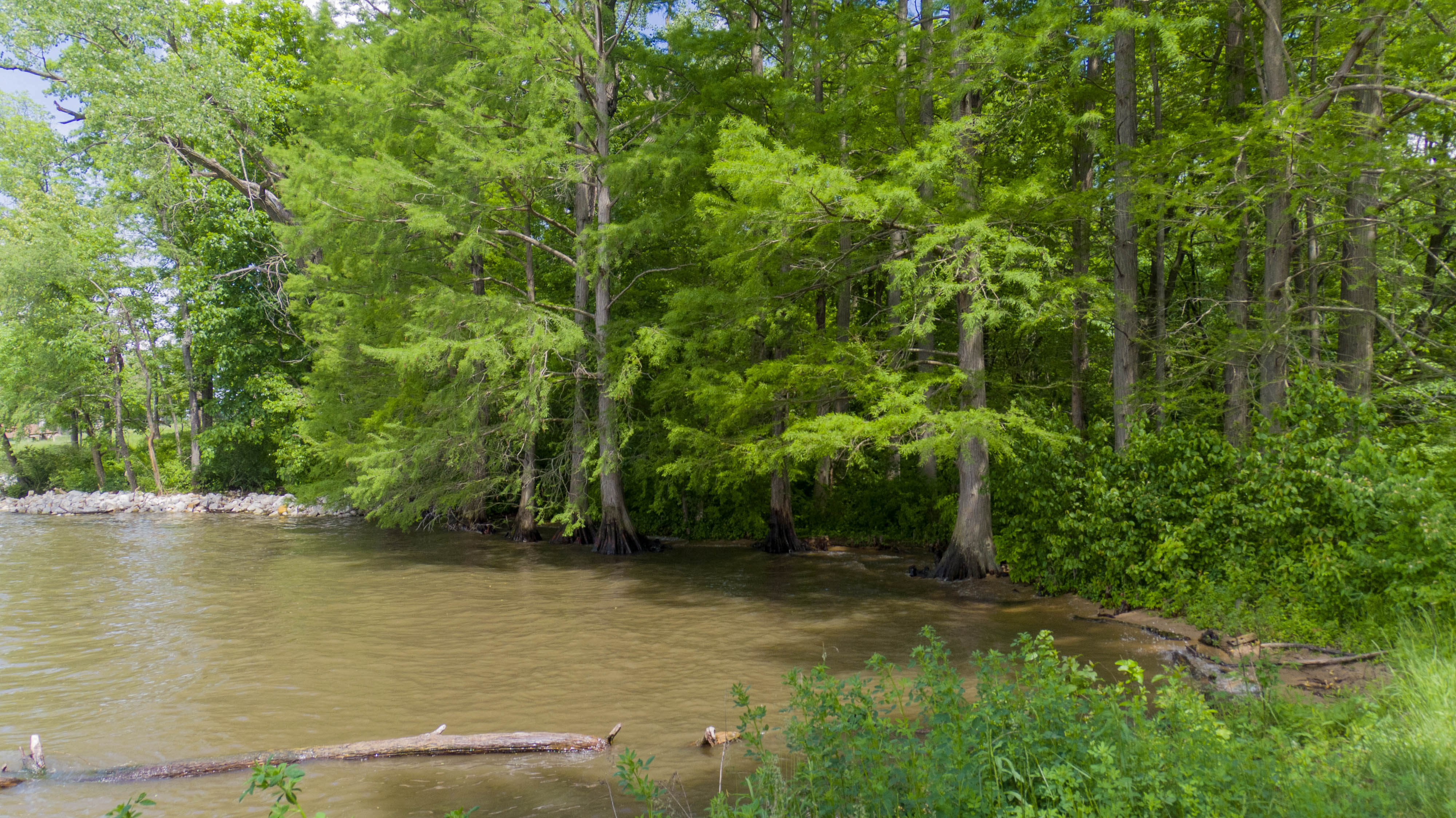
View of the bald cypress grove. (Justin Myers, 14 East)
A person standing in the shadow of the cypresses can see the smokestacks of the city’s coal-fueled power plant sending billowing plumes high into the sky across the lake’s waters. On the surface, the plant rises in stark contrast to this seemingly untamed scene around the trees. Beneath its naturalistic façade, however, there was one thing this greenery shared with the harshness of the stacks: both were made with human hands, not nature.

City, Water, Light & and Power’s plant on the shore of Lake Springfield (top right) as viewed beside the bald cypress grove. (Justin Myers, 14 East)
Of course, the trees, grasses, flowers and rambling bushes would not have grown, save for the organic biology of plants. However, their placement and design were laid out and lectured to by a team of people who gave their sweat and strength to see the vision for this space realized.
As his hands traced out gently sweeping shapes and penned designations for plant species, landscape architect Jens Jensen would, in 1935, draft the blueprint that would turn a 63-acre strip of pastureland with less than a dozen trees into what stands today: a garden in memory of Abraham Lincoln created in such a fashion that its visitors could convince themselves that no human feet had ever tread its paths. Thus began Lincoln Memorial Garden, the place the cypresses called home.
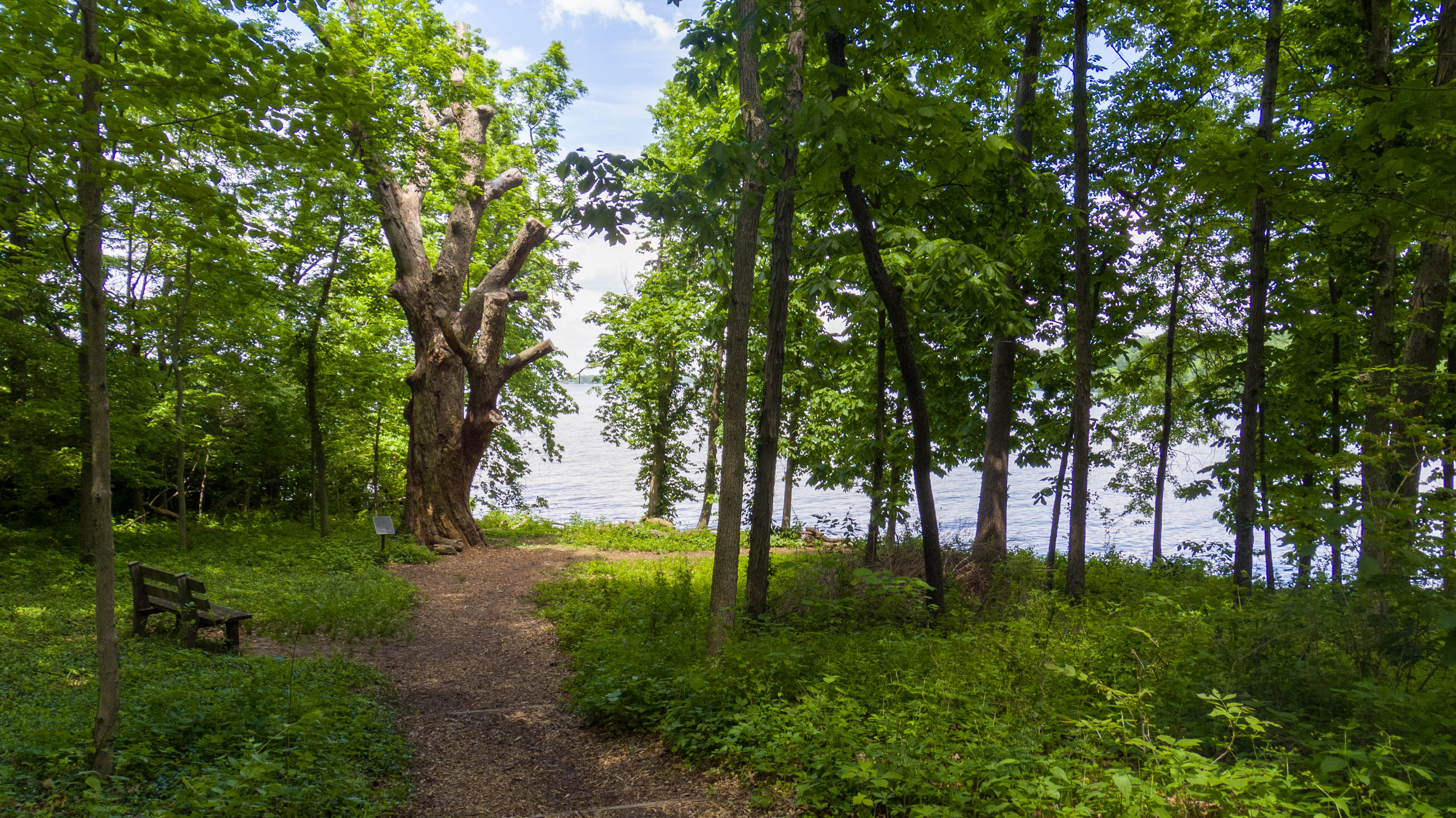
The massive chinkapin oak pictured top left in this image was one of the few trees present on the garden’s grounds when it was planted. It was given the name of the “Constitution Tree” because it was alive during the signing of the Constitution in 1787. The oak began exhibiting health problems in 2018 and has since been assumed to be deceased. (Justin Myers, 14 East)
Jensen came from a generation of visionaries who tied themselves to the “prairie school” of thought. They used the natural landscape of the Midwest to guide their art.
As with his colleagues, the prairies and wildflowers spoke to him. Jensen was a Danish immigrant who arrived in America in 1884 and fell in love with its boundless plains of tall grasses, dense forests and geology, especially the rough limestone outcroppings found throughout the region.
However, unlike fellow prairie school architect Frank Lloyd Wright, Jensen preferred the everchanging, dynamic world of green spaces over the unchanging rigidity of homes and other buildings, which grew only as big as the hands that built them made them to be. He sought to not only gain inspiration from but to rebuild the prairie and natural ecosystem of the Midwest.
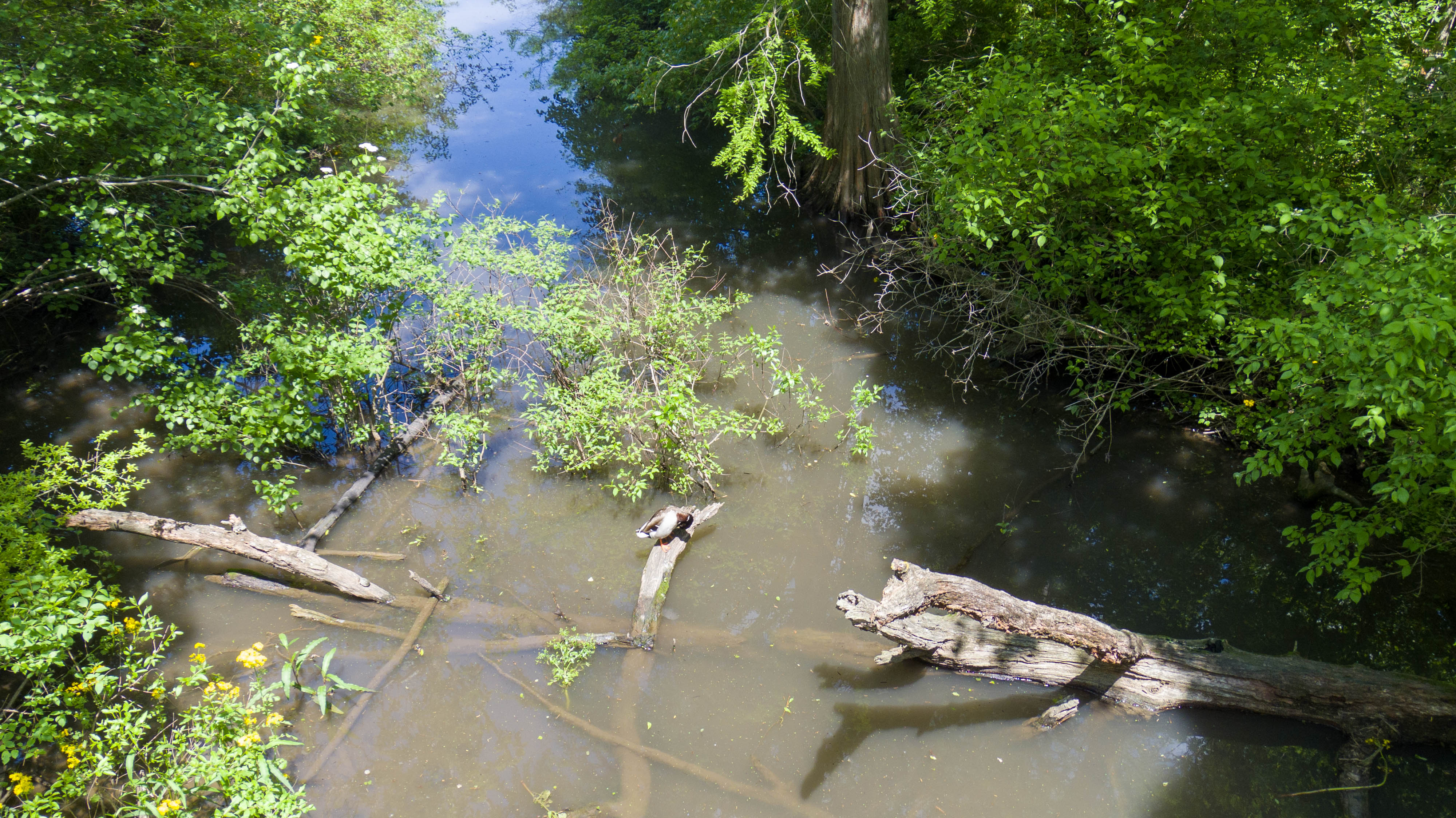
A fallen tree lies across a creek at Lincoln Memorial Gardens as a duck preens itself amid new growth. (Justin Myers, 14 East)
Plants, unlike Wright’s terra cotta and stone edifices, grow long after they’ve been rooted in soil and are living. This creates a system of unique needs and factors to be considered for their preservation. The century that has passed since the creation of these landscapes has, in many cases, altered Jensen’s original vision for these spaces through their organic maturation and necessitated for them to be reimagined in a modern context.
For those serving as caretakers to Jensen’s landscapes, these themes of intent, vision and time are daily considerations. Stewardship of Jensen landscapes in the 21st century is also not merely comparing the original design to what is now in place. It’s a constant exercise in applying modern knowledge to ensure the longevity of historic landscapes both to preserve their environmental health and to keep the sites relevant to the communities in which they live.
A Seed is Sown
Jensen’s work was often limited to his blueprints, which were placed in the hands of his employers. He played very few active roles in the planting, construction and early maintenance of his designs.
“I think that he felt that most of his landscapes would have gardeners or trained staffs that knew how to manage them,” said Robert Grese, professor emeritus at the University of Michigan and a scholar of Jensen.
Lincoln Memorial Gardens was lucky. Not only was Jensen partially active in its construction, but it also had the support of a team of volunteers led by Harriet Knudson, a member of the Springfield Civic Garden Club, who saw the idea for the gardens through from its conception to her death in 1969. A key component of her leadership was her understanding of Jensen’s idea for the space and her ability to translate and pass it on to others.
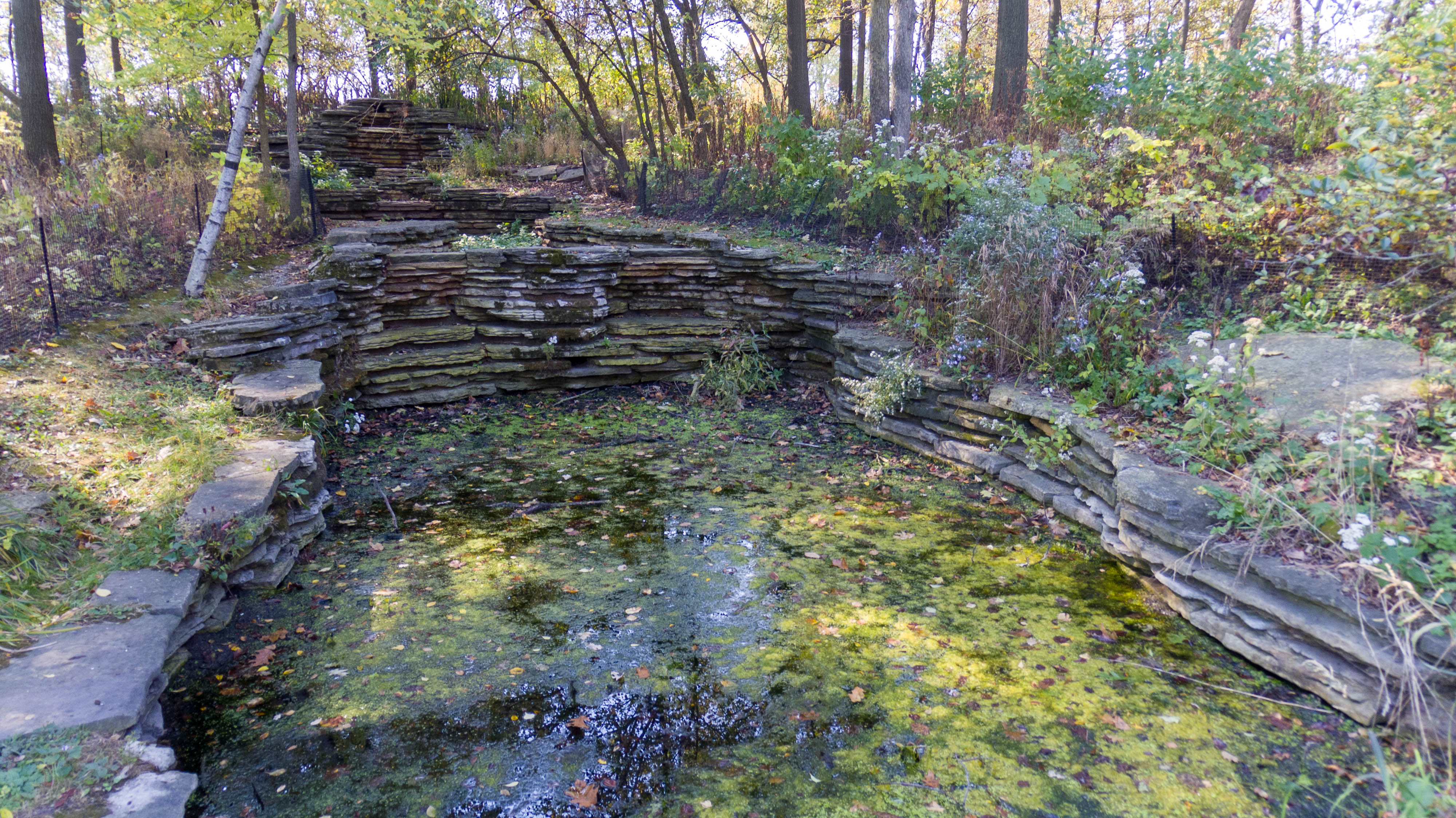
Natural or maintained? This Jensen-designed waterfall at Columbus Park in Chicago, managed by the city’s park district seems to lean towards the former. (Justin Myers, 14 East)
During its construction, several competing ideas were presented regarding the degree to which the gardens should be left to their natural state or maintained. Knudson mediated these debates in a way that kept the space true to the natural environments Jensen had strived to replicate while ensuring that the site was maintained enough to ensure its usability by visitors. For example, trees that fell across paths would be cleared by workers, but a rotting log lying alongside the path would be left to the natural processes of decay.
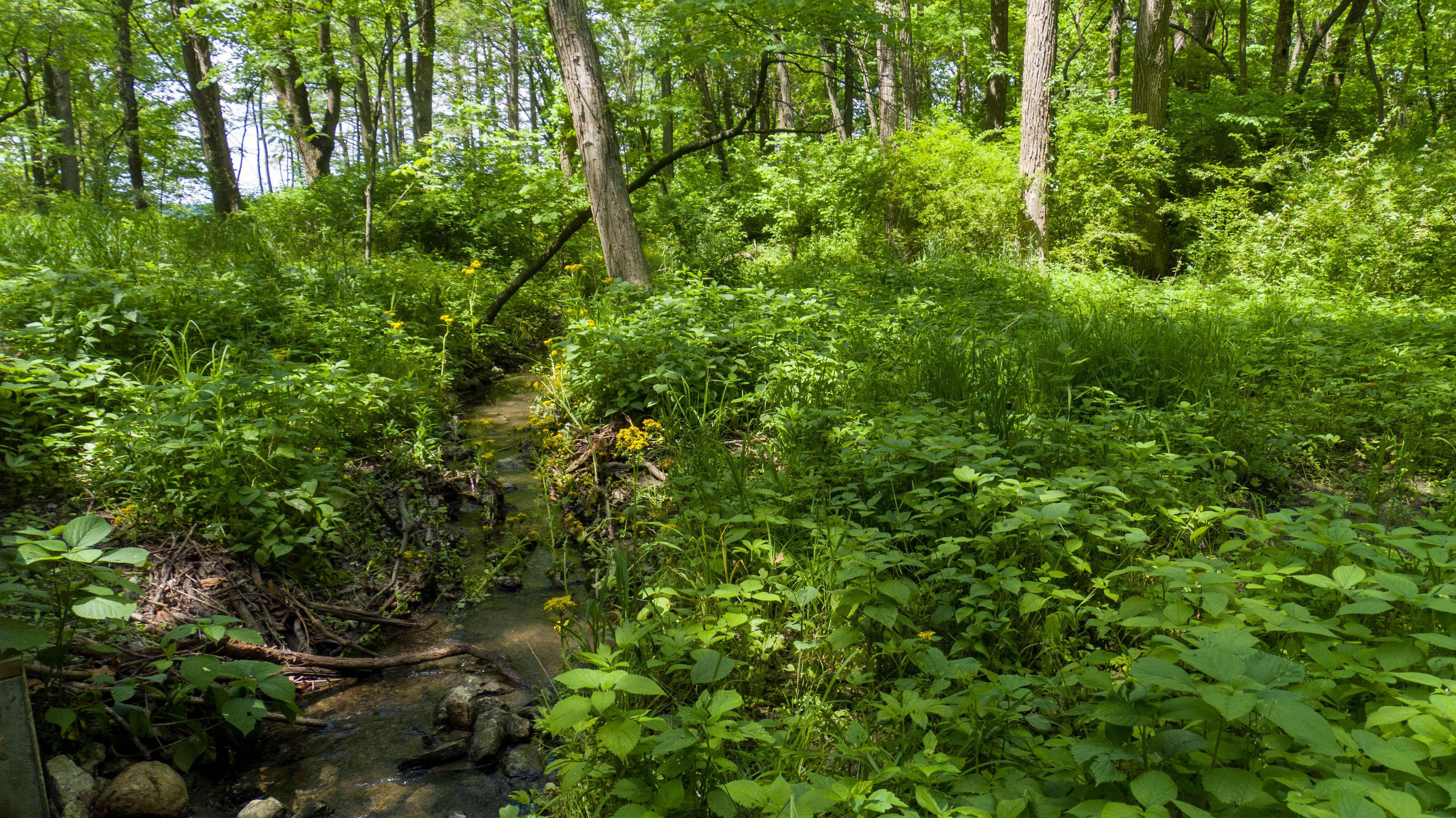
This creek at Lincoln Memorial Gardens showcases Knudson’s philosophy for the maintenance of the park. Dead branches sit in their natural state along the river, but the path across the creek (not pictured) is well kept and free of debris. (Justin Myers, 14 East)
Today, Miller carries on Knudson’s practice of preserving Jensen’s core vision for Lincoln Memorial Gardens in his day to day work and career at the site.
When Miller first began the volunteer work that would lead to his employment at Lincoln Memorial Gardens, the decade and a half following Knudson’s death had placed the site in the hands of Springfield’s City Water, Light and Power (CWLP) company, who built the coal-fired plant across the lake. Legally, the city owns the land on which the gardens sit and has a responsibility for its upkeep, hence CWLP’s involvement.
Miller attributes a lack of funds and manpower to the decline in the landscape’s integrity that occurred during this era of the gardens’ history.
He can still relate the scenes he saw when he first began work at the gardens. A wall of Japanese honeysuckle, an invasive species in Central Illinois, choked out the underbrush in the gardens’ Lake Trail. Above, thick wild grapevines weighed down branches.
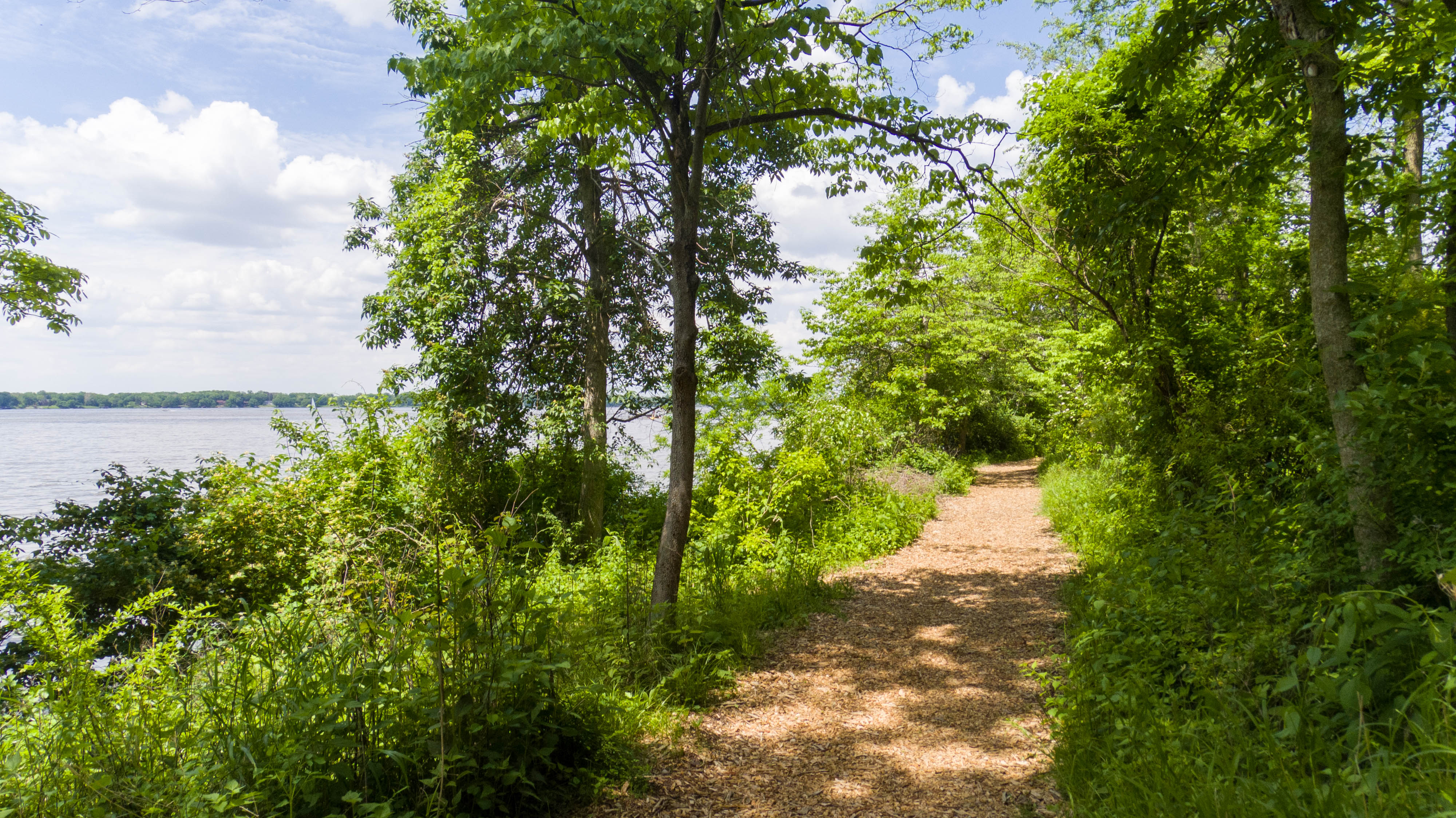
Lake Trail today. (Justin Myers, 14 East)
As he began the task of trimming this unwanted brush and spraying down the stumps with herbicide to ensure it wouldn’t sprout back up, a curious thing began to happen.
From deep in the ground, the white petals of bloodroot and the bright Spring blossoms of Virginia bluebells began to shoot up from the ground and bloom.
“I’ve always believed that most plants — a lot of plants — if you just give them the right conditions, they’ll flourish,” Miller said.
The flowers, which sprouted in response to the care taken to restore the gardens, had come from seeds that had lain dormant for years, waiting for the shadow of the invasive brush to be cleared. Now, having had their ideal conditions restored, the plants once again grew.
Art Under Glass
In Chicago, 180 miles northeast of Lincoln Memorial Gardens, the glass walls of the Garfield Park Conservatory have become a vegetative forum. There, Mary Eysenbach, director of conservatories for the Chicago Park District, lets the plants have their own voice in planning the space’s indoor landscape.
The conservatory’s tropical delights seem to run contradictory to Jensen’s prairie style, yet they exhibit a sophisticated blending of the natural landscape with the exotic.
When first inside the Garfield Park Conservatory, it may come as a surprise that the forest of tropical plants and exotic blooms which meet visitors as they enter its doors is another Jensen design. However, through a canopy of the thick fronds of palms hugged by sweet-smelling orchids, the vision of Jensen’s prairie school thinking can still be found.
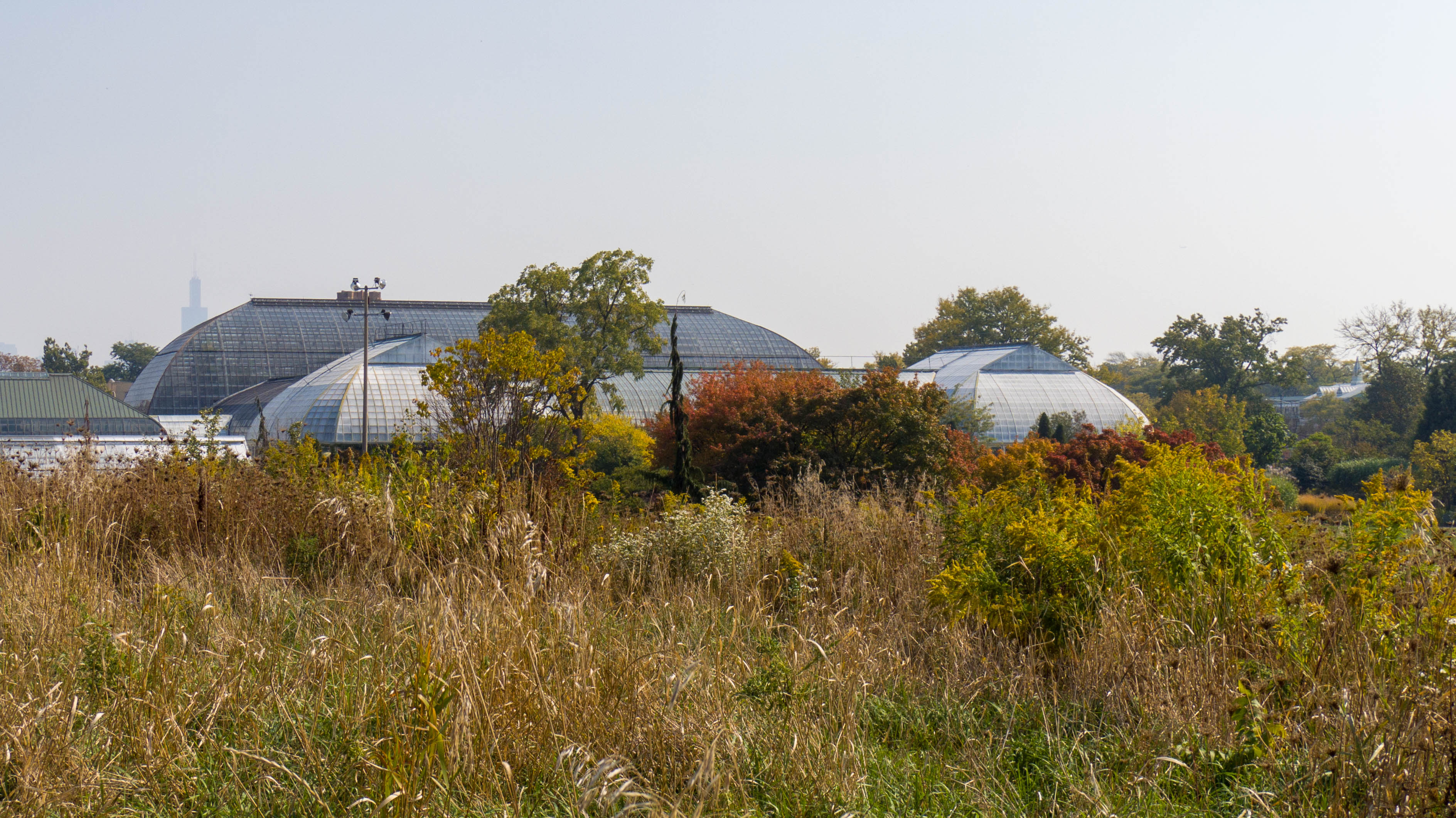
Jensen’s design for a conservatory in Chicago may sound counterintuitive to his naturalistic school of thought, but the outer shell of the Garfield Park Conservatory emulates a vision of haystacks on an Illinois prairie. (Justin Myers, 14 East)
First, there’s the sloping walls of the building itself, which were designed by Jensen in 1905 to mimic haystacks against a prairie landscape. The plants, though exotic, are planted into sunken flower beds resembling an outdoor space, which was against the trend among conservatories at that time to place their specimens in pots.
Though, despite the controlled environment of the conservatory and all of Jensen’s careful planning, the plants will still have their way amid the beauty of the space, and it’s up to Eysenbach to sit back and listen to the music of their demands.
Though an artificially constructed environment, Garfield Park Conservatory still must pay attention to the organic variability of the sun’s rays. The aroid house is one example of how the design of the conservatory has been adapted to best serve this natural element.
“When the conservatory first opened, the aroid house was actually the conifer house,” Eysenbach said. “Turns out, they didn’t do so well in that room.”
The conservatory utilizes a steam heating system with vents to regulate heat and whitewashes its windows to help diffuse light in the bright summer months. However, the variability of the sun’s rays as they hit the various “rooms” and “houses” within the conservatory complex — one of the largest in the country — is variable depending on their placement and cannot be controlled by these means. This is what led to the original conifer house transitioning to a space for aroids — a family of plants that includes philodendrons and monsteras and which thrives in low light.
Post-Jensen’s original design, this has necessitated paying close attention to the individual needs of plants.
“Originally, there was no desert house, but that changed over,” Eysenbach continued. “I think people figured out, in terms of sun and heat, what would grow best in that room.”
This Agave americana plant in the desert house earns the nickname “century plant” due to the amount of time it takes to bloom, which is about 15 to 20 years. When it finally does bloom, it sends out a massive flower shoot the size of a telephone pole before dying. In 2019, glass panels from the conservatory’s room had to be removed to make way for this monumental botanic display.
An Interpretative Role
Letting the plants talk not only ensures that their ideal growing conditions are met but provides a translator for how Jensen’s designs should be allowed to mature over time.
Fair Lane was a direct challenge to the formal traditions of aristocratic landscape architecture present at the time of its construction, yet some formal elements persisted amid Jensen’s naturalistic vision due to the Fords’ insistence.
In 1915, automobile giant Henry Ford welcomed the completed construction of his estate Fair Lane in the Detroit suburb of Dearborn, Michigan, though it wouldn’t be until four years later that the family settled into the residence. Upon recommendation by Hermann von Holst, whose architecture firm designed the house at Fair Lane, Ford hired Jensen to design the landscaping for the 1,300-acre property.
Jensen’s plans for the sprawling estate included a hydroelectric dam disguised by limestone outcroppings to appear as naturally formed river rapids. A V-shaped meadow at the estate was designed so that the setting sun on the summer solstice would come to rest at the exact spot at which two lines of trees on either side came to meet each other at the V’s point, bathing the entire estate in peach-colored light.
Today, Karen Marzonie, director of landscapes at Fair Lane, and Annie Rubel, director of preservation and operations at Fair Lane, work in tandem to interpret the original visions of Fair Lane’s architects in the 21st century. Though Marzonie focuses on the estate’s grounds and Rubel focuses on its buildings, the two’s work overlaps with a holistic look at the site’s historic preservation, but there’s a clear difference between their areas of expertise.
“A building can be frozen in time,” Rubel said. “But a landscape is very much alive.”
“You’re balancing allowing a landscape to grow and change versus trying to maintain the character and the historic intention, so that that landscape doesn’t change beyond recognition,” Ruble said. “What integrity looks like with a building and what authenticity looks like in a building is a different interpretation and can be managed differently than a landscape.”
Buildings decay, fade and wear out over the years, but their size does not increase unpredictably and organically like that of a plant would. With the grounds, restoring them to a state perfectly in line with the way they looked when the Fords first enjoyed the space would be not only impossible but against Jensen’s beliefs.
Marzonie shared the following quote from Jensen:
“It will be interesting for you to note the changes that will take place as things now in youth grow into maturity. It is really first in maturity that life is most beautiful — when it has run its journey and speaks its story complete.”
“I kind of keep that in the back of my head all the time,” Marzonie said. “Where there once was a meadow-scape, now it’s a forest. Are we going to cut down the forest and recreate the landscape of 1919? No, because even Jensen would say, ‘I’m so glad those that those sugar maples grew up and those oak trees came in.’ But, there’s still a sense in our minds to hold on to some integrity of the design.”

At Columbus Park in Chicago, flowers have bloomed in an unintended place, adding pops of color to a century-old council ring. (Justin Myers, 14 East)
The Experience of Nature
Henry’s son Edsel, the heir to the Ford automobile fortune, followed in his father’s footsteps when it came to his choice of Jensen as the landscape architect for his estate in Grosse Pointe Shores, Michigan — a 35-minute drive northeast from Fair Lane.
This estate, referred to as the Edsel & Eleanor Ford House (abbreviated as “Ford House”), paralleled and magnified what Jensen had accomplished through Fair Lane’s grounds.
The Edsel & Eleanor Ford House’s shoreline along Lake St. Clair was a breathtaking and favorite feature for the family, as shown in this home movie of Edsel Ford and his son Benson. Yet, its prominence as a visual feature on the grounds is intentionally limited. Jensen used the natural shoreline’s beauty and draw to his advantage, using his landscape to give, delay and take away views to add intrigue to his design.
Jensen especially toyed with the view of the estate’s shoreline along Lake St. Clair and an artificial cove he designed to provide shelter for Edsel’s boats.
The cove is created on one side by the property’s natural shoreline and a thin peninsula running parallel to the shoreline on the other. Though technically a peninsula, it was built out of a sandbar by Jensen to serve the Ford’s avian interests and gave it the name “Bird Island.” On it, he placed plants such as chokeberry shrubs and elm trees to give food and shelter to all sorts of feathered inhabitants.
In 2015, a channel was dug to sever Bird Island’s peninsula from the mainland to allow fresh water to pass more freely from the cove to deter stagnation and algae blooms.
At the time of the project, it had been almost 90 years since the estate’s initial construction began. Time brought with it changes to the ecosystem at the site and on Bird Island. Koto works to address these changes, which have been caused by a combination of an altered landscape and environmental changes.
The peninsula has an uneven topography, and one side is higher than another. On the lower side, high water levels along the lake have begun to transition the side to a wetland ecosystem. On the other, the removal of trees has created a patch of open space.
Bird Island was a creative solution constructed by Jensen to meet the needs of the Ford family.
Koto looks at these not as a detriment to the integrity of the landscape but as an opportunity.
“We’re looking at it from an ecological point, but then we’re also rolling into it educational opportunities,” Koto said. “We’re kind of taking that idea of native plants which Jensen would have used and restoring the different ecosystem types on the island, but then doing it also in a way that we can have educational opportunities for the public.”
The lower-lying area is slated to be reimagined as a designated wetland ecosystem, rather than pursuing efforts to keep it in its original state. The higher clearing is planned to become a prairie with other educational microecosystems dispersed throughout the island.
“Whereas, a lot of the grounds, we’re really focused on restoring them to the time period. Where the island gets, we’re really restoring it to an ecological mindset, not a historical,” Koto said. “So, it’s very much looking at the ecosystem first, then looking at the cultural, the historical part of it.”
Dynamic but Not Lost
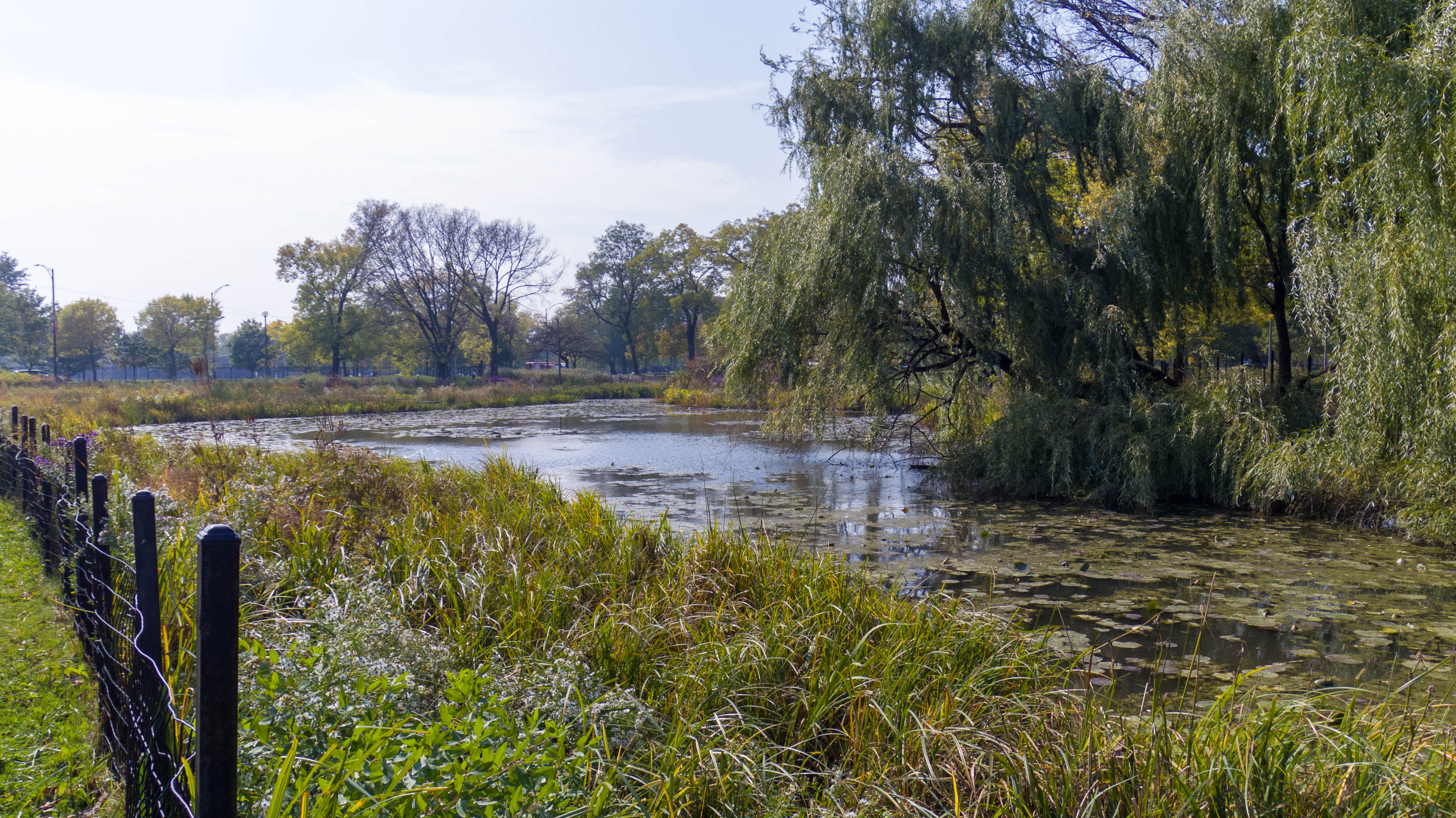
Jensen’s “prairie river” at Humboldt Park in Chicago. (Justin Myers, 14 East)
From his council rings (rings of rough hewn limestone which were intended to be places of discourse) to the musical rush of a waterfall under glass to vast gardens designed to captivate their visitors, Jensen’s work has survived a century of existence thanks to the careful consideration of intent, vision and time. Though these concepts have led to dynamic changes in some of the original functions of his designs, his work has not been lost due to their implementation.
“I don’t think he ever thought about his landscapes as being static and just staying the same,” Grese said. “But yet, some of the principles and the views and the basis he was trying to create were strong enough to guide that landscape over that long period of time.”
Header image by Justin Myers


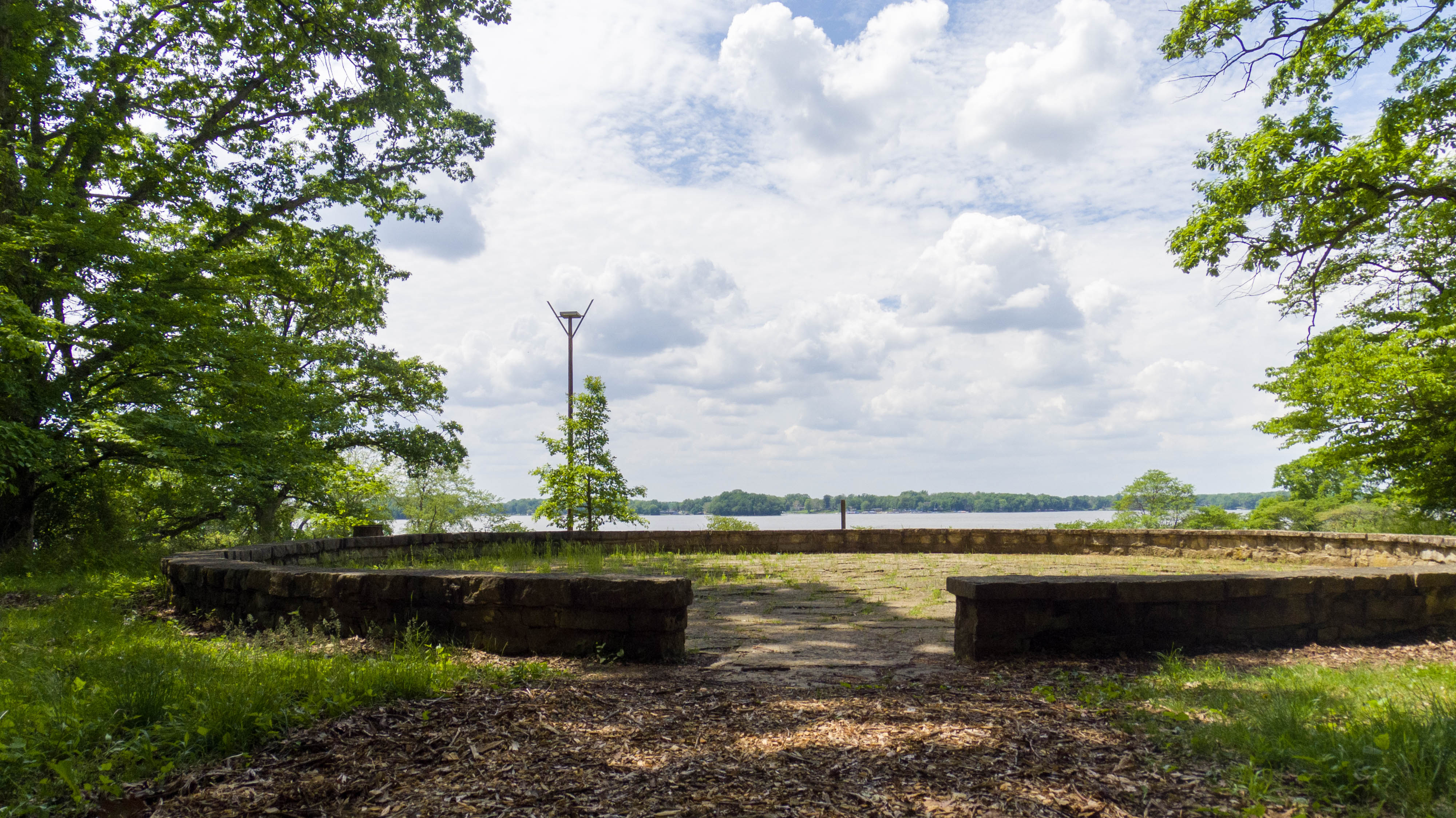

NO COMMENT